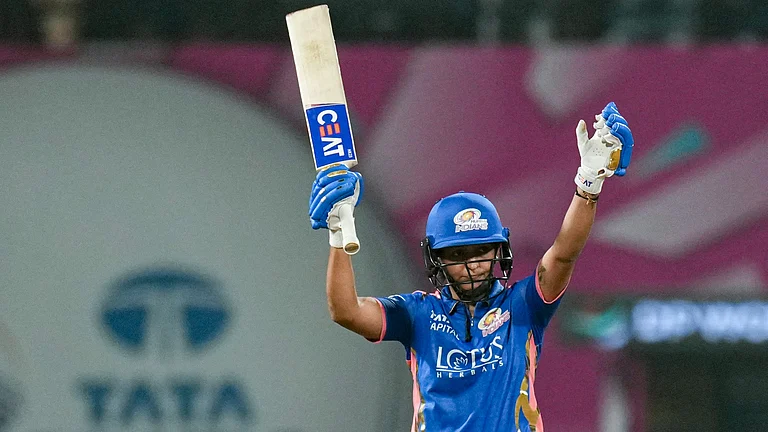In September 2021, Rohit Sharma stood smiling at The Oval. He had passed the ultimate test for any batsman from the Asian subcontinent - scored a second innings hundred in a Test-winning cause on SENA (South Africa, England, New Zealand, Australia) territory. Sharma’s 127 had helped India take a 2-1 lead over England in a five-match series.
Jump to June 2023. The venue was the same. This, too, was an ‘Ultimate Test’, according to the signage at the ground. But this time it was a tale of woe for Sharma as well as his team. Australia thrashed India by 209 runs in the World Test Championship (WTC) final. If not for the application shown by Ajinkya Rahane, Ravindra Jadeja and Shardul Thakur with the bat in the first innings, the margin might have been even bigger. Sharma often cut a somber figure during the match. Not in the least because his own form has been average for a while. For a leader, that is never easy to live with.
So yet again, India have floundered in an ICC event, and in conditions out of their comfort zone. The Oval pitch had a bouncy malevolence to it, as could be seen by the number of blows batsmen took on their bodies during the match. Add to it the hardness of the Dukes ball which was used in the match. According to an analysis on Day Four by Ravi Shastri and Nasser Hussain, the new ball jumped 72 cm higher than when it got older. That’s almost two and a half feet.
There were many other reasons for India’s defeat.
Fatigued Bowlers
Indian fast bowlers, resigned to bowling on flat tracks back home, crave the sight of a juicy pitch. But when they got one at The Oval, they were too tired to do much about it. Mohammed Shami, Mohammed Siraj and Co arrived in London barely a week after a draining, two month IPL. Shami and Jadeja, two men crucial to the bowling attack in London, were both involved in the IPL final on May 29.
It is easy to blame scheduling. But a packed calendar is a reality of cricket. The truth is no one wants to compromise on the IPL, not the players, the franchises or the BCCI. The middle path between income and workload management is not an easy one to find and most times money wins out.
Could the WTC final have been held at least a few days later, giving players a few more days to recover from the IPL? Not really, as the Ashes commences in England on June 16.
Could the WTC final have been played somewhere else, then? Again, not quite. Other countries are not deemed ideal venues at this time of the year for reasons ranging from weather to audience interest, especially for a game that does not necessarily feature the home team.
The Indian board and players simply have to find a way to balance club and country workloads. Shastri recommended putting in a release clause in players’ IPL contracts.
“There should be a clause in the IPL contract that if they need a player out of the IPL in the interest of India, they have the right to do it,” he said.
Spinning Tracks At Home
One reason India liked their chances in the WTC final was that they have dominated the Test rivalry against Australia in the last decade. Going into the Oval clash, India had won the Border-Gavaskar Trophy four times in a row, and twice on Australian soil. Australia have actually not beaten India in a Test series since 2014-15.
However, India’s homework going into the WTC final was mostly at home, and on wickets that were often so spin-friendly that they were seen by many as unfit for cricket. The Indore Test against Australia in March is a glaring example. Fourteen wickets fell on Day One. The pitch boomeranged on India, too, as the hosts lost the Test in a little over two days. The ICC Match Referee Chris Broad gave the wicket a ‘poor’ rating, before it was changed to ‘Below Average’ after an appeal from the BCCI.
Player Performance
But even in the absence of IPL fatigue or other compromising factors, India have lost in ICC events. At the 2021 World Test Championship final, for example, there was no IPL burn out. That year’s league had been suspended due to COVID. But India still lost to Kane Williamson’s New Zealand. At the 2022 T20 World Cup, India raised hopes by reaching the semis, but were demolished by England. Many expected India to put Pakistan to bed in the 2017 Champions Trophy final. But even against an opponent India has dominated, they faltered.
The fact is that there remains a troubling imbalance between India’s status as the world’s most powerful cricketing nation and its performances in ICC tournaments. It is now a decade since we last won an ICC trophy.
Debates will go on if Hardik Pandya and R Ashwin should have been picked for the WTC final, and if India should have batted first after winning the toss. Questions will also be asked of heavyweights like Sharma and Virat Kohli, both of whom underperformed in London. But they must also be asked of the BCCI. A goal has to be set of winning an ICC Trophy, and then all preparations need to be tailored towards that goal, including the kind of pitches the team plays on. Speaking purely of Test cricket, Sanjay Manjrekar recommended moulding players specifically for the format, and picking suitable talent from domestic cricket. He gave the example of Travis Head and Steve Smith, who, for various reasons, did not play the IPL. Their 285-run partnership in the first innings at The Oval virtually sealed the match for Australia, and once again ICC silverware faded from our sights.

























